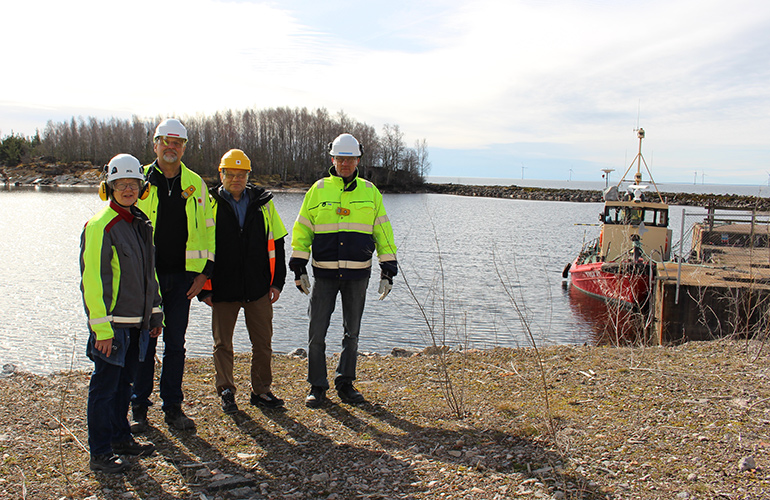100 years by the lake
Water has always played a central role in Skoghall Mill, one of the world’s largest manufacturers of paperboard for liquid and foodstuff packaging. 100 years ago, when the mill first started-up, logs were drifted along the waters for sawing. These days, water is used in production, heating, cooling and cleaning processes.
Today you could jump in for a swim or fish right in front of the mill. However, the situation hasn’t always been the same. Just a few decades ago the waters were polluted by fibrous wastes and other discharges. “Still in the 70s you could see white rafts of foam floating in the front of the mill, but thanks to improved waste water treatment facilities in municipalities, industry and agriculture, the levels of dissolved organic materials in the water have been restored to preindustrial levels.” explains Margareta Sandström, Environmental Manager at Skoghall Mill.
The mill has done numerous improvements in its water management systems during the past decades. “We can be proud of the fact that even though the mills production capacity has steadily increased over the years, we have been able to cut the chemical oxygen demand of our effluents significantly, meaning that the discharged water has less organic pollutants” says Lennart Vieweg, Environmental Engineer at Skoghall Mill.
Margareta Sandström, Lennart Vieweg, Matts Hjort and Tomas Gustafsson.
However, taking care of the ecological state of the European Union´s largest lake can’t be achieved alone. Vieweg participates on behalf of Stora Enso in the work of the Lake Vänern Society for Water Conservation. This organisation provides a forum for discussing issues related to the lake's water quality, and identifying the necessary solutions. The mill also cooperates with local universities and research facilities to stay aware of any changes in the lakes condition.
What can be measured, can be managed
In 2017 the mill stepped up a new gear in its water management as a new target was set in place. “In the next three years we aim to decrease our water use by 10% compared with the levels of 2016,” explains Sandström.“Currently we use 100 000 of cubic meters of water daily. Approximately 60 % of it´s used in the process and 40 % is used for cooling and heating. We both take water from the lake as well as discharge water into it after having it carefully purified. Our high-performing wastewater treatment systems ensure that discharged water is ecologically safe and meets all regulatory requirements.” explains Klas Norborg Development Engineer. Group-wide almost 96% of the water Stora Enso withdraws is recycled back to the local environment after being carefully purified.
“As a first step towards the target we will place emphasis on closely measuring and visualising our water intake.” describes Tomas Gustafsson, Environmental Engineer at Skoghall. A clear way of monitoring and measuring is important so that we can focus our work on the right actions and optimize our processes.” adds Senior Specialist Matts Hjort.
“All of this is environmentally as well as economically smart,” stresses Sandström. “When we use less water, we need fewer chemicals for purification. In addition, we can cut our energy costs as processes needed for water circulation in the mill can be decreased.”
Small streams make great rivers
Progress to achieve the target is already on the way. Smart, sustainable solutions don’t always mean massive investments or brand new technologies. For example the mill has applied circular economy thinking by keeping water longer in closed loops.“We´ve already been able to reduce our mill´s fresh water intake by replacing it with recycled and cleaned filtrate in one of our board machines,” explains Norborg. “At the same time we have been able to recover fibre from the water so that they don’t end as effluent, but as raw material for new board."
Finding savvy ways to utilise wastewater sludge that is created during the purification processes is also important. Wastewater sludge is used as bio-based energy at the mill, after the dryness and energy value has increased through an effective screw press. Sludge can also be used in the production of soil fertilizers.
Clean water also for the coming 100 years
Like Skoghall, most of Stora Enso´s production units are located in regions where water is relatively abundant. This however doesn’t mean that water should be taken for granted. Water scarcity may impact our operations in the long term through our supply chains, and as controls on pollution, recycling, and water pricing are toughened. To ensure a group-wide focus on water, Stora Enso introduced a new KPI for total water use at its board, pulp, and paper mills in 2017.Sandström also sees a need for a shift in the way water is thought about. “As much as improving our water management is about technical improvements it should also be about the way we think about water. Water is a scarce commodity that can only be loaned - nothing is for free. Just a few decades ago for example we didn’t regard steam energy as something that has a price tag on it. I believe the same thing is happening to the way we think about water.”






